The week at a glance
- Brown Flycatcher in East Yorkshire
- Eastern Olivaceous Warbler still in East Yorkshire
- Frigatebird sp. off Aberdeenshire and Lothian
- Probable Pallid Harrier in Borders
- Influx of Ortolan Buntings
In what was undoubtedly the best migration week of the year so far, it seemed that good-quality birds were on all coasts. A high-pressure area over Scandinavia brought plenty of interest in the east and early fallout from the start of the hurricane season had a similar effect in the west. However, it was surprising how few of the commoner scarcities (an intentional oxymoron) filtered inland.
First of the real 'megas' was another fly-by seabird, this time an unidentified frigatebird past Peterhead (Aberdeenshire) on 8th. It was seen mid-morning by experienced observers at half-distance, allowing reasonable views, but specific identification will always be difficult. Incredibly it was then seen 100 miles away heading past North Berwick (Lothian) at 19:15 in the evening.
Another frustratingly brief bird was a probable juvenile Pallid Harrier at Mire Loch (Borders) on 4th, with presumably the same bird later at Eyemouth. Away from Shetland (where there are nine records) there are just two Scottish records, on Orkney in 1995 and in Perth & Kinross in 1993.
Further south, the interest came in passerine form. The Eastern Olivaceous Warbler remained in the Old Fall plantation, Flamborough Head (East Yorkshire) until 3rd, but was rather elusive at times. This was trumped, though, with the finding of a Brown Flycatcher at Buckton (East Yorkshire) on 5th–6th. It showed well at times, but in the evening and late morning next day it caused plenty of confusion, with Garden Warbler, Willow Warbler and Pied Flycatcher all variously strung as the bird. With records now in 2007 (from nearby Flamborough) and 2008 (Fair Isle), many will now be hoping for a longer-staying bird. Interestingly, this may also resurrect some interest in two previous records, both accepted and later rejected: on Holy Island (Northumberland) in September 1956 and on Great Saltee (Co. Wexford) in September 1957.
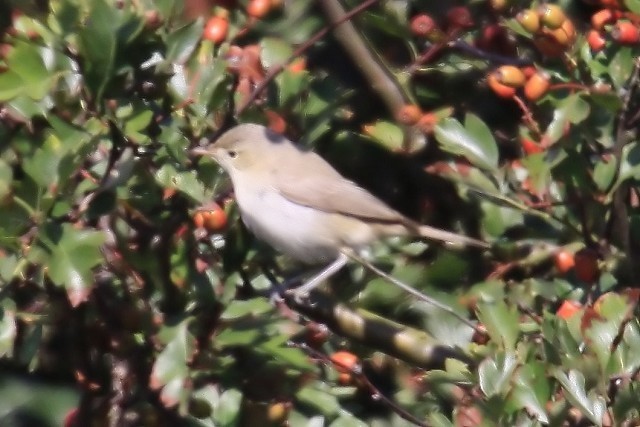
Eastern Olivaceous Warbler, Flamborough Head, East Yorkshire (Photo: Brian Henderson)

Brown Flycatcher, Buckton, East Yorkshire (Photo: Dave Mansell)
There were some other intriguing 'probables' this week, including House Crow reported in Cobh (Co. Cork) on 5th, Iberian Chiffchaff heard calling at Heacham (Norfolk) on 8th and an unconfirmed report of a Song Sparrow seen on 4th around new housing estates on Selsey Bill (West Sussex).
Last, and least for some, the male House Finch resided at East Prawle (Devon) to 7th at least.
With some moulting wildfowl now departed, those left included the two adult and three juvenile Snow Geese at Outertown (Orkney) on 3rd, and Ferruginous Ducks at Chew Valley Lake (Somerset) all week and another drake at Pitsford Reservoir (Northants) on 3rd–7th. Ruddy Shelducks continued to pop up as well, with one at Cut End (Lincolnshire) on 3rd, later at Freiston Shore (Lincolnshire) on 6th. There were then three at Wouldham (Kent) on 2nd and singles at Stutton Mill (Suffolk) on 2nd, Oare Marshes (Kent) on 5th and Priory Country Park (Bedfordshire) on 7th. Other ducks of note included a Marbled Duck, with the usual 'unknown origin' tag, at Broom Gravel Pits (Bedfordshire) on 8th and the female American Wigeon at Glaslyn Marsh (Gwynedd) until 5th. On the sea, drake Surf Scoters were at Blackdog (Aberdeenshire) on 2nd and in Largo Bay (Fife) on 3rd.
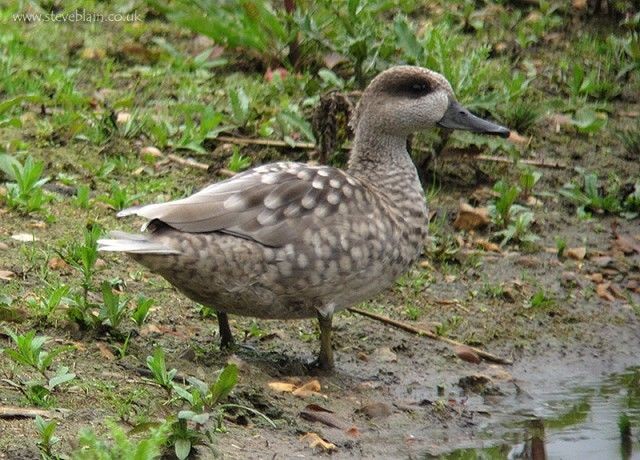
Marbled Duck, Broom GPs, Bedfordshire (Photo: Steve Blain)
Sea passage has slowed again, although Cory's Shearwaters were seen past Filey (North Yorkshire) on 2nd, past Southwold and Corton (Suffolk) on 4th, lingering off Donna Nook (Lincolnshire) on 5th, past Carnsore Point (Co. Wexford) on 6th and there was an unconfirmed report of one off Holme NOA (Norfolk) on 6th. The only Great Shearwater went past Mine Head (Co. Waterford) on 6th. Balearic Shearwater numbers were lower, though still managed peaks of 52 past Porthgwarra (Cornwall) on 5th, 11 past Berry Head (Devon) on 6th and 11 past Hartland Point (Devon) on 8th. Similarly, there were few reports of Sooty Shearwaters, with a peak of just 12 past Fife Ness (Fife) on 5th.
Last week's small arrival of Glossy Ibis continued, with birds scattered around Ireland including two still at Shannon Airport (Co. Clare) to 6th and singles at Tacumshin (Co. Wexford) to 4th, the Rogerstown estuary (Co. Dublin) to 5th and one new bird at Lough Aterdaun (Co. Clare) on 3rd–5th. In England, one east over Cotswold Water Park (Wiltshire) on 2nd pre-empted the arrival of a flock of 21 birds on the Otter estuary (Devon) on 7th–8th. Six of these were colour-ringed, so it will be interesting to see if they are Spanish or French birds. One other bird also wandered round Devon and Dorset, seen at Teignmouth and Burton Bradstock (Dorset) on 7th and at Lodmoor (Dorset) on 8th.

Glossy Ibis, Otter Estuary NR, Devon (Photo: Gavin Haig)
White Storks were at Inishbofin (Co. Galway) on 3rd–4th and at Clachan (Argyll) on 4th, and the only Purple Heron was one at Martin Mere (Lancashire) on 3rd. Egrets were also few in number, with the two Great White Egrets still at Meare Heath/Shapwick Heath (Somerset) to 7th, one at Dungeness (Kent) still to 7th and others at Fremington Quay (Devon) on 2nd, and 21 Little Egrets, and the colour-ringed adult again at Blashford Lakes (Hampshire) on 8th. Single Cattle Egrets were then at Chepstow (Gwent) on 2nd, Kingfisher Bridges (Cambridgeshire) on 3rd–4th, Dungeness (Kent) again on 5th and on the Nene Washes (Cambridgeshire) on 7th.

White Stork, Inishbofin, Galway (Photo: Dermot Breen)
The only raptor interest was the wing-tagged White-tailed Eagle on the Farne Islands (Northumberland) until 5th, a Black Kite over Bodmin (Cornwall) on 5th and the impressive sight of over 60 Buzzards 'kettling' over Spurn (East Yorkshire) on 3rd.
The Spotted Crakes remained at Shibdon Pond (Durham) until 6th, with others at Radley Gravel Pits (Oxfordshire) on 3rd–8th, Willington Gravel Pits (Derbyshire) on 3rd–4th, Kenidjack Valley (Cornwall) on 7th and one flushed from the dunes at Spurn (East Yorkshire) on 7th. Equally unexpected was a Corncrake flushed from the dunes at Holme NWT (Norfolk) on 3rd.
There was just one record of Kentish Plover, a juvenile at Blythburgh (Suffolk) on evening of 3rd. American Golden Plovers remained at Poulnasherry Bay (Co. Clare) until 4th, and on North Ronaldsay (Orkney) until 7th, with a flush of arrivals later in the week. One was on North Uist (Outer Hebrides) on 4th–5th and again on 7th, and possibly another on South Uist on 6th–7th. Others were at Loch Gruinart, Islay (Argyll) on 4th–7th, Gearagh (Co. Cork) on 4th–5th, a possible at Arnside (Cumbria) on 5th and at Hamnavoe, Yell (Shetland) on 7th–8th.

American Golden Plover, Hamnavoe, Yell, Shetland (Photo: Dougie Preston)
In a similar vein, Buff-breasted Sandpipers arrived en masse. Up to four were on the airfield on St Mary's (Scilly) on 3rd–8th, with 'twos' at Ballycotton (Co. Cork) on 7th–8th, Murvey (Co. Galway) on 7th, Dursey Island (Co. Cork) on 8th and at Pilmore (Co. Cork) on 8th, with a singleton at Lissagriffin (Co. Cork) on 8th.
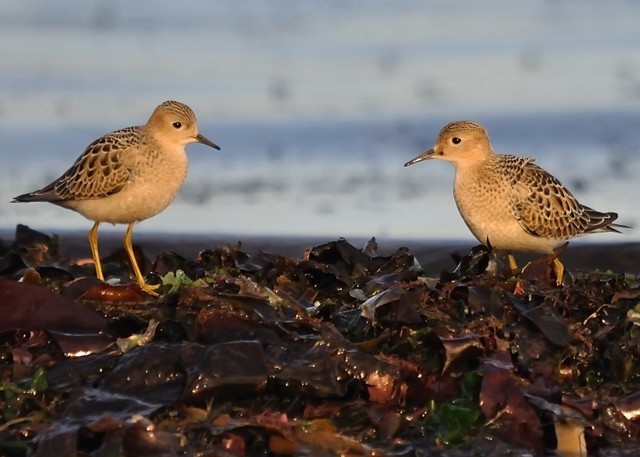
Buff-breasted Sandpiper, Ballycotton, Cork (Photo: Ronan McLaughlin)
As might be expected, Pectoral Sandpipers were also in good numbers, with singles at Cullaloe (Fife), Colliford Lake (Cornwall), Tory Island (Co. Donegal), Lough Oughter (Co. Cavan), North Ronaldsay (Orkney), the Bann estuary (Co. Londonderry), Elmley Marsh (Kent), Holland Haven (Essex), Loch Leven (Perth & Kinross) and Belfast Lough (Co. Antrim). Records of two came from Muckrush (Co. Galway), The Shunan (Orkney), Gearagh (Co. Wexford), Hollowell Reservoir (Northamptonshire) and the Hayle estuary (Cornwall), with three at Tacumshin (Co. Wexford) on 7th.
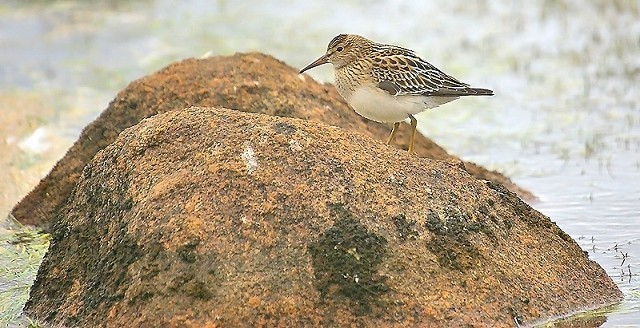
Pectoral Sandpiper, Tory Island, Donegal (Photo: Derek Charles)
There were fewer Semipalmated Sandpipers, with one still in Tyninghame Bay (Lothian) to 8th, one at Blennerville (Co. Kerry) on 4th–6th and a probable juvenile at Loch Bee, South Uist (Outer Hebrides) on 5th.
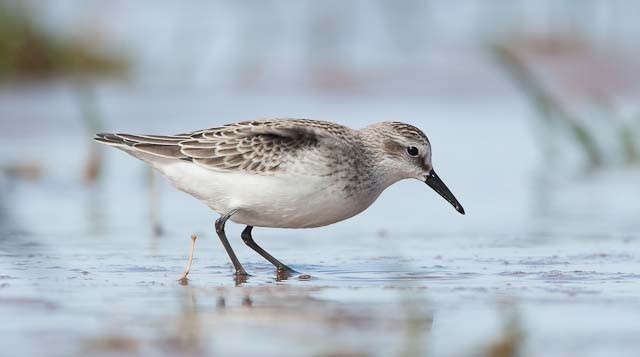
Semipalmated Sandpiper, Tyninghame Bay, Lothian (Photo: Peter M. Macdonald)
The only White-rumped Sandpiper was at Ballynamona (Co. Cork) on 2nd and there was plenty of confusion surrounding a Baird's Sandpiper at Cley (Norfolk). A bird first reported on 4th was later reidentified as a Little Stint, although there was then a report of one again on 5th. Another bird was then reported at Ventry (Co. Kerry) on 2nd.
There was a report of a probable Lesser Yellowlegs at Porth Hellick, St Mary's (Scilly) on 4th and the wandering Long-billed Dowitcher was again at Connah's Quay (Conwy) on 3rd. New in was a Great Snipe flushed twice from The Warren at Spurn (East Yorkshire) on 4th then again at Beacon Ponds the next day, although not confirmed.
The juvenile Red-necked Phalarope remained at Slimbridge (Gloucestershire) to 8th (also 25 Curlew Sandpipers there) and new birds were at Holme NOA (Norfolk) on 3rd–7th, Coonagh (Co. Limerick) on 3rd–6th and at Draycote Water (Warwickshire) on 7th–8th. From the other side of the pond, there was a flush of Wilson's Phalaropes, with a first-winter at Ventry (Co. Kerry) on 6th–7th, one on the Hayle estuary (Cornwall) on 6th (with two Pectoral Sandpipers) and one on the Great Pool, Tresco (Scilly) on 8th.

Red-necked Phalarope, Holme NOA, Norfolk (Photo: anon)
Big gulls have really yet to arrive, with just adult Glaucous Gulls at Lerwick (Shetland) on 3rd and Port Nis, Lewis (Outer Hebrides) on 4th and a second-summer at Clonea (Co. Waterford) on 6th. The American Herring Gull was reported again at Blennerville (Co. Kerry) to 6th. The only remaining Ring-billed Gulls were at Rossi's Ice Cream Parlour in Westcliffe-on-Sea (Essex) to 7th, Stanpit Marsh (Dorset) until 7th, and a new bird was at Black Rock Strand (Co. Kerry) until 4th. The wandering Bonaparte's Gull in Durham continued to wander, seen at Seaham on 3rd and then at Ryhope on 4th.
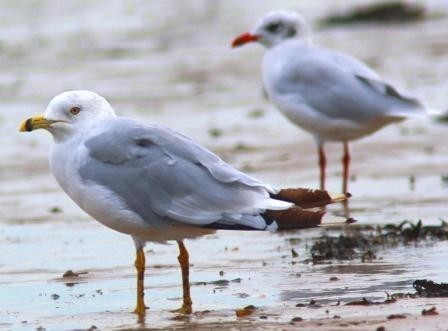
Ring-billed Gull, Westcliff-on-Sea, Essex (Photo: Jm)
Sabine's Gull records were fewer in number, with juveniles past Strumble Head (Pembrokeshire) on 2nd, Loch of Strathbeg (Aberdeenshire) on 6th and Freiston Shore (Lincolnshire) on 6th, and adults off Maidens (Ayr) on 4th, in Cobh harbour (Co. Cork) on 5th and past Spurn (East Yorkshire) on 5th.
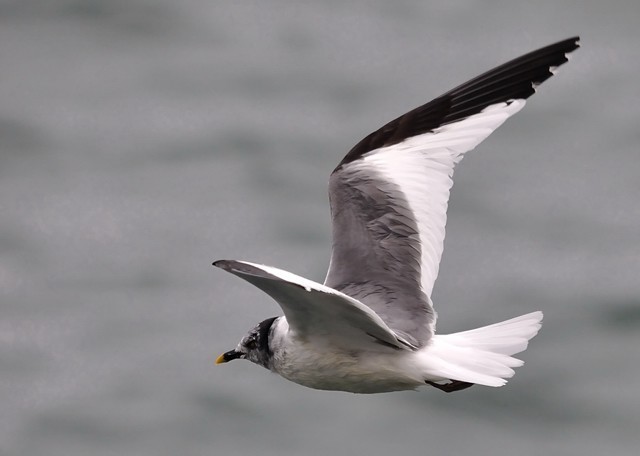
Sabine's Gull, Cobh, Cork (Photo: Ronan McLaughlin)
A Whiskered Tern was at Annesley (Nottinghamshire) briefly on 4th, and one discovered at East Chevington (Northumberland) on 7th–8th was later reidentified as a White-winged Black Tern. Another WWBT was at Southfield Reservoir (East Yorkshire) on 6th. There was a real tern-fest at Rutland Water (Leicestershire), with the juvenile Whiskered Tern remaining until 7th, joined by a Black Tern on 5th and a juvenile White-winged Black Tern on 7th.
In Ireland, the female Snowy Owl was again at Blacksod (Co. Mayo) on 4th.
With a good easterly airflow come migrants, and Wrynecks were recorded in a wide range of counties, though predominantly south of a line from Yorkshire to Lancashire. Sites with two birds included Dursey Island (Co. Cork), West Bexington (Dorset), Hartlepool Headland (Cleveland), Holy Island (Northumberland), Newbiggin-by-the-Sea (Northumberland) and Hengistbury Head (Dorset) with three at Land's End (Cornwall) on 8th. Birds were ringed in West Yorkshire, Lincolnshire, Somerset, Cambridgeshire and East Yorkshire. Unfortunately one at Samphire Hoe (Kent) was killed by a train and one Somerset bird was killed by a Stoat.
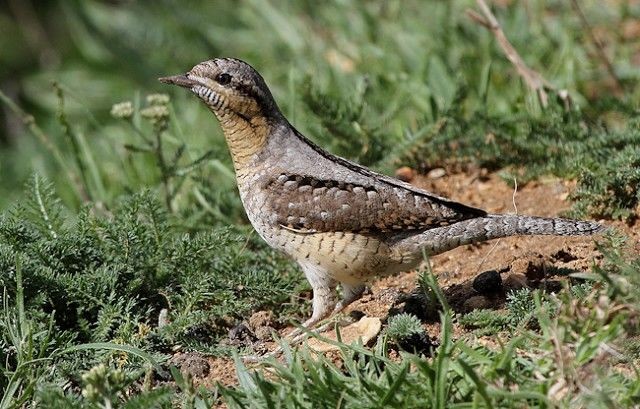
Wryneck, Holland Haven CP, Essex (Photo: Sandra Standbridge)
Some more typically spring migrants also arrived, with two Hoopoes at Baltimore (Co. Cork) on 2nd, Short-toed Larks again on Blakeney Point (Norfolk) on 4th and 7th (amazingly able to disappear for days on end on this well-watched site) and at Polgigga (Cornwall) on 5th–6th, and the only Red-rumped Swallow was over Kew, Spurn, and then Kilnsea (East Yorkshire) on 7th.
There was an odd report of a Tawny Pipit 'recently' at Keyhaven Marshes (Hampshire), although this was never confirmed, nor access arranged. Citrine Wagtails were very much in evidence, with a possible reported at Elmley Marsh (Kent) on 2nd, a first-winter in Nanquidno valley (Cornwall) from 3rd–7th and one still on the cricket pitch on St Agnes (Scilly) on 4th. Others were at Baltasound, Unst (Shetland) on 6th, a possible first-winter at Treraven Meadows, Wadebridge (Cornwall) on 6th and one at Chew Valley Lake (Somerset) on evening of 7th.
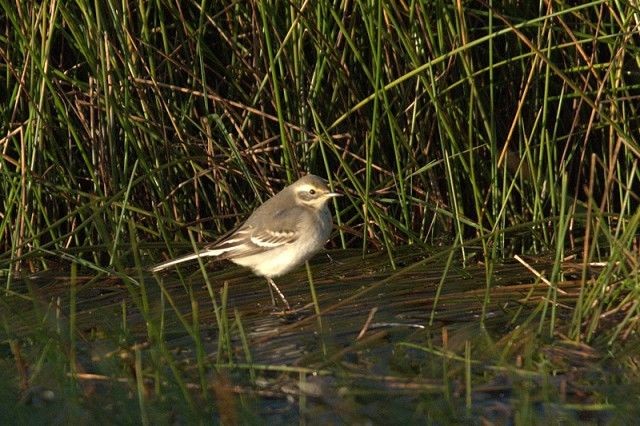
Citrine Wagtail, Baltasound, Unst, Shetland (Photo: Mike Pennington)
The year's second Lesser Grey Shrike was on St Mary's (Scilly) on 8th: the first on the islands since 1976! Other shrikes included a Woodchat Shrike at Three Castles Head (Co. Cork) on 2nd–5th (also Red-backed Shrike, Wryneck and Icterine Warbler there) and Red-backed Shrikes in Kent, Co. Cork, Somerset, Norfolk, Bedfordshire, Northumberland, Scilly, Berkshire, Hampshire and Suffolk, with birds reaching Aberdeenshire and Lothian on 7th. One at Spurn showed off a shiny ring, but as none have been ringed at the site it gave wardens the run-around. Sites with two birds were Cape Clear (Co. Cork) and Holme NWT (Norfolk).

Lesser Grey Shrike, St. Mary's, Isles of Scilly (Photo: Joe Pender)

Red-backed Shrike, Minsmere RSPB, Suffolk (Photo: Jon Evans)
On the warbler front, an Aquatic Warbler was ringed at Steart (Somerset) on 4th, with a probable seen briefly at Beachy Head (East Sussex) on 7th and a possible at West Bexington (Dorset) on 8th. A Marsh Warbler on the Farne Islands (Northumberland) on 5th (also Wryneck, three Lapland Buntings, 29 Redstarts and Fieldfare there) was followed by birds at Newbiggin-by-the-Sea (Northumberland) and Filey (North Yorkshire) on 8th.

Aquatic Warbler, Steart, Somerset & Bristol (Photo: Rog Musgrove)
A Booted Warbler was at Grimston (East Yorkshire) on 4th and another was ringed at Bamburgh (Northumberland) on 8th.
As with Wryneck, Barred Warblers turned up all along the entire east coast in small numbers, with the only birds in the west being at Hoylake (Cheshire) on 3rd and Mizen Head (Co. Cork) on 4th. Sites recording two birds included Flamborough (East Yorkshire), Holme NOA (Norfolk), Yell (Shetland), Fetlar (Shetland), Kilnsea (East Yorkshire) and Mire Loch (Borders). There were then three on Out Skerries (Shetland) on 4th and numbers at Spurn (East Yorkshire) peaked at six on 7th, a day that also produced two Wrynecks, 73 Redstarts, 52 Pied Flycatchers, 42 Spotted Flycatchers, 27 Tree Pipits, 29 Whinchats and four Fieldfares at the site.

Barred Warbler, Flamborough Head, East Yorkshire (Photo: Andy Hood)
Icterine Warblers were almost as widespread, with birds along all coasts. At least 26 birds were reported, with 'twos' at Garinish Point (Co. Cork) and at North Gare (Cleveland). One of these was ringed, with others caught in Cheshire and Dorset. Other possibles (or Melodious Warblers) were at Trewellard (Cornwall) and Bawdsey (Suffolk) and a possible Melodious (or Icterine) was at Porth Clais (Pembrokeshire). Co. Cork had the lion's share of Melodious Warblers, with two at Mizen Head and singles at Galley Head, Old Head of Kinsale and Cape Clear. Others included two ringed on Bardsey (Gwynedd) over 2nd–7th, one on Lundy (Devon) on 4th (also the year's first Western Bonelli's Warbler on the same day), and the Isles of Scilly saw one on Bryher on 2nd and one on St Mary's on 4th.
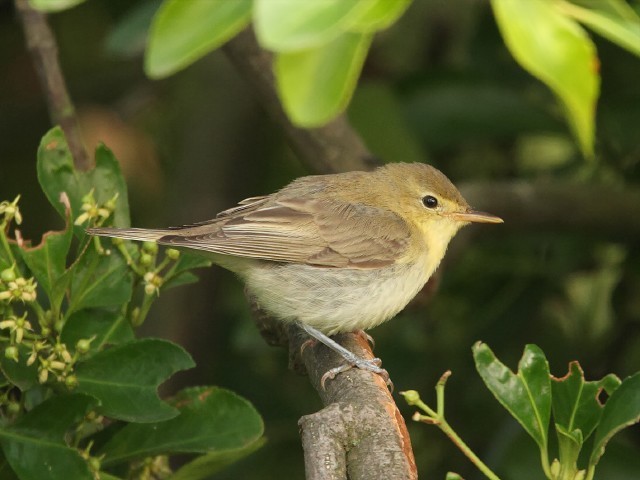
Icterine Warbler, Landguard NR, Suffolk (Photo: Chris Mayne)
Greenish Warblers were spread along the east coast, with one remaining on St Mary's Island (Northumberland) until 3rd and new arrivals at Spurn (East Yorkshire) on 2nd, The Lea, South Shields (Durham) on 2nd–3rd, Scatness (Shetland) on 4th, Strawtown (Co. Cork) on 5th–7th, Galley Head (Co. Cork) on 6th, Thorpeness (Suffolk) on 6th–8th, Flamborough (East Yorkshire) on 7th (also two Wrynecks, two Barred Warblers, two Common Rosefinches, Icterine Warbler, three Wood Warblers and five Firecrests there) and Newbiggin-by-the-Sea (Northumberland) on 8th.

Greenish Warbler, Thorpeness, Suffolk (Photo: Jon Evans)
Arctic Warblers were scarcer, but still in good numbers: at Scatness (Shetland) on 4th, Sumburgh (Shetland) on 4th–5th, Out Skerries (Shetland) on 4th, ringed at Holme NOA (Norfolk) on 6th (present until 8th) and one on Dursey Sound (Co. Cork) on 6th–7th.
There was just a single record of Rose-coloured Starling, a juvenile at St Ouen's Pond (Jersey) on 4th and just one Bluethroat, at Spurn (East Yorkshire) on 4th. East Yorkhsire also saw a possible samamisicus Redstart at Buckton on 4th, adding some credentials to the Brown Flycatcher arrival.
The first Red-breasted Flycatcher of the autumn was uncharacteristically in the west, at Loop Head (Co. Clare) on 4th. It was followed by an arrival of birds later in the week at the more expected east-coast locations of Kilnsea (East Yorkshire) on 6th–8th, Bempton Cliffs (East Yorkshire) on 6th, Donna Nook (Lincolnshire) on 6th–8th, Hartlepool Headland (Cleveland) on 7th, Barns Ness (Lothian) on 7th–8th and Sammy's Point (East Yorkshire) on 8th.
Common Rosefinches were distributed much further north, with good numbers in the Northern Isles, including three at Quendale (Shetland) on 3rd and five on Fair Isle (Shetland) on 4th (also four Barred Warblers, Marsh Warbler and 110 Lapland Buntings there). The furthest south was one at Humberstone Fitties (Lincolnshire) on 6th and the furthest west was on Great Saltee (Co. Wexford) on 7th (also two Wrynecks there) and birds were seen daily at Spurn (East Yorkshire), with six recorded on 7th.

Common Rosefinch, Spurn, East Yorkshire (Photo: Martin Standley)
The big arrival of buntings continued, but this time it was Ortolans. After two on Three Castles Head (Co. Cork) on 2nd–6th, birds were seen at Noirmont Point (Jersey), Bryher (Scilly), Galley Head (Co. Cork), Bardsey (Gwynedd), Porth Meudwy (Gwynedd), with House Sparrows at Holmpton (East Yorkshire), Beachy Head (East Sussex), Kelling Heath (Norfolk), Kilnsea (East Yorkshire), Filey (North Yorkshire), Porthgwarra (Cornwall), Bempton Cliffs (East Yorkshire), Portland (Dorset) and Holy Island (Northumberland). 'Twos' were recorded on Inner Farne (Northumberland) on 7th and at Spurn (East Yorkshire) on 7th–8th, though an incredible six were seen in Nanquidno Valley (Cornwall) on 4th–7th.

Ortolan Bunting, Filey, North Yorkshire (Photo: Dave Mansell)
Early in the week numbers of Lapland Buntings were still high, with a massive 250 at Balranald, North Uist (Outer Hebrides) on 3rd and 184 on Fair Isle (Shetland) on 2nd. Other high counts included over 150 at Aird an Runair, South Uist (Outer Hebrides) on 2nd, 71 near Kinlochbervie (Highland) on 2nd and at least 68 at Brough of Birsay (Orkney) on 2nd. The highest count further south was of 24 at Point of Ayr (Isle of Man) on 4th and there were single-figure counts across much of the country, though all were on the coast.
Photo of the Week: 26th August—1st September
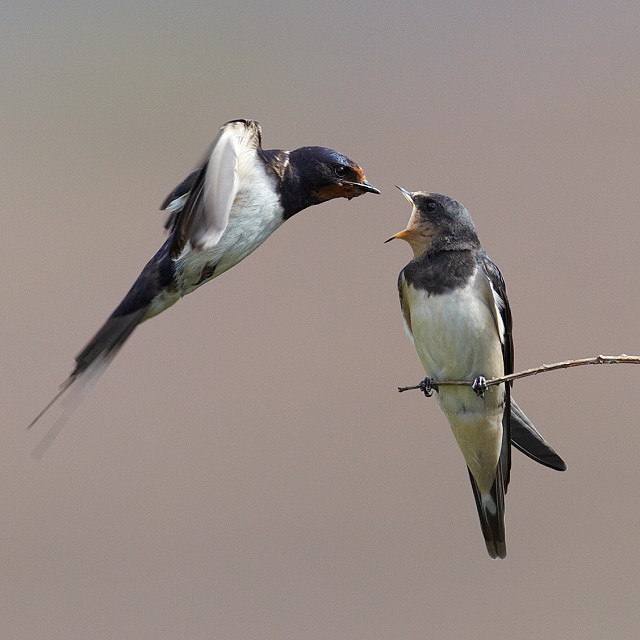
Swallow, Hartland Moor, Dorset (Photo:
Simon Johnson)
A characteristic of bird images that is not often talked about is their 'seasonality': some images could have been taken at any time of the year, whereas others clearly relate to a specific period in the calendar. Highly seasonal images have the added advantage of evoking the experience of the relevant season. At this time of year, a shot of Fieldfares in the snow could bring an unwelcome chill, whereas a typical summer image could help keep us in denial about the dark, cold days to come. Combining the strong summertime associations of Swallows and the feeding of young birds, Simon Johnson has captured a real 'image of the moment'. Simon's simple composition of two birds against a plain background, with only a twig as an additional element, makes the image leap off the screen, whilst the proximity and eye contact of the subjects convey the strength of their bond.
Other notable photos
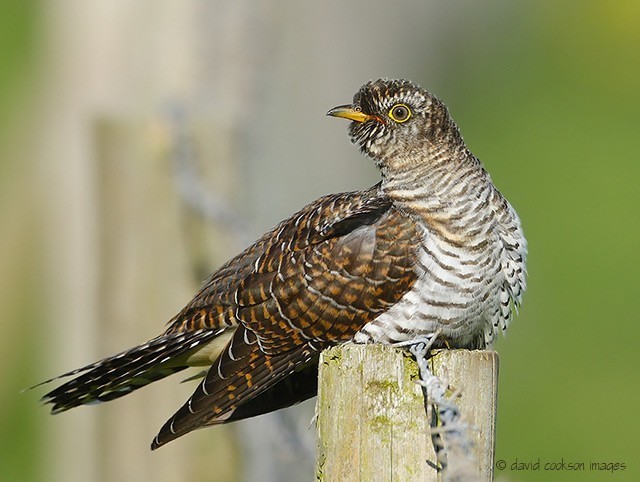
Cuckoo, undisclosed site, Lancashire (Photo:
David Cookson)
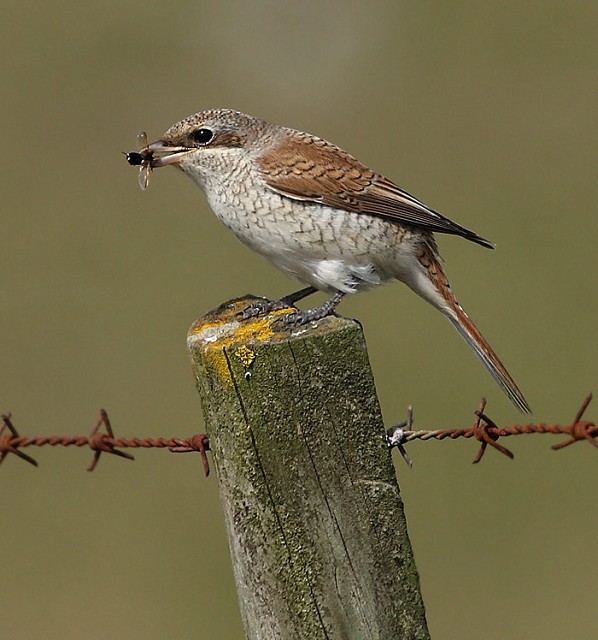
Red-backed Shrike, Stolford, Somerset & Bristol (Photo:
James Packer)

Sand Martin, Bawdsey, Suffolk (Photo:
Jon Evans)

Indian Robin, India (Photo:
Kit Day)

Ruff, Oare Marshes NR, Kent (Photo:
Ian Curran)

Dotterel, Pleinmont, Guernsey (Photo:
Steve Levrier)

Short-eared Owl, Old Hall Marshes RSPB, Essex (Photo:
Pixellence)

White-tailed Eagle, Loch na Keal, Mull, Argyll (Photo:
Steve Hiscock)

Common Kestrel, Otmoor RSPB, Oxfordshire (Photo:
Tom Hines)
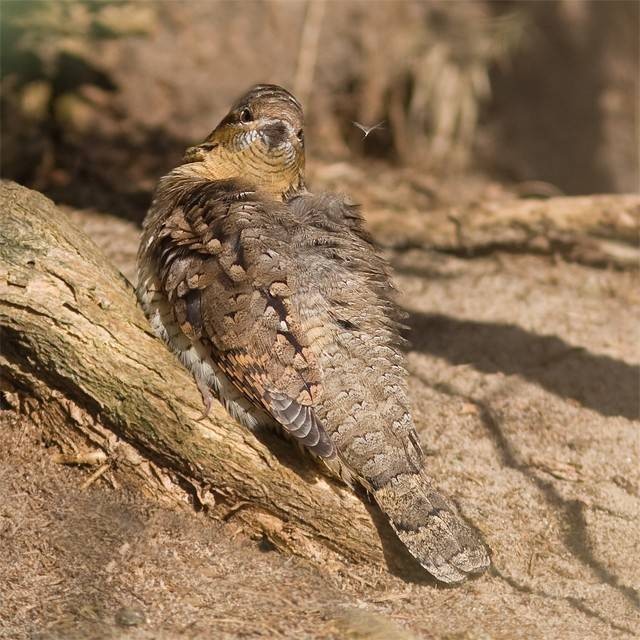
Wryneck, Minsmere RSPB, Suffolk (Photo:
David H Hatton)

Spotted Redshank, Sandwich Bay, Kent (Photo:
Steve Ashton)

Meadow Pipit, Strathconon, Highland (Photo:
Ron McCombe)
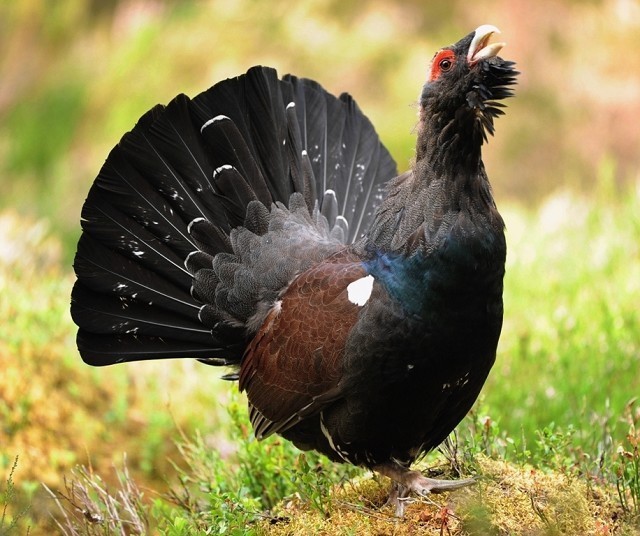
Capercaillie, undisclosed site, Highland (Photo:
Rob Sewell)

Curlew Sandpiper, Instow, Devon (Photo:
Roy Churchill)

Lapland Bunting, Fort Island, Isle of Man (Photo:
Pete Hadfield)
Photo of the Week: 2nd—8th September

Gannet, Ailsa Craig, Ayrshire (Photo:
Jimmy MacDonald)
From his base in Argyll, Scotland, photographer Jimmy MacDonald does an excellent job of capturing not only his local bird species, but also the broader natural environment in which they live. Through his website, he brings to life his subjects through writings as well as photographs, always managing to convey the passion he feels for wildlife. Importantly, in an age when camera technology makes bird photography accessible to almost anyone, Jimmy has developed his own distinctive style in the way he captures and processes his images. On a recent boat trip to the Gannet colony at Ailsa Craig, where most photographers would be content with standard close-ups of these stunning birds, Jimmy opted for the more challenging task of freezing the birds as they plunged into the water for their fishy hand-outs. With a photo quite unlike any of the other thousand Gannet images we've received, Jimmy's dramatic action shot compels the viewer to look twice to work out exactly what they're looking at. His trademark high-contrast 'look' works well in this case to turn a well-timed shot into a creative, abstract image.
Other notable photos

Wryneck, Llanrhystud, Ceredigion (Photo:
Kev Joynes)

Curlew Sandpiper, Draycote Water, Warwickshire (Photo:
Dave Hutton)

Red-backed Shrike, Reculver, Kent (Photo:
Steve Ashton)

Wren, Blashford Lakes HWT, Hampshire (Photo:
Martin Bennett)

Common Redshank, Salthouse, Norfolk (Photo:
David Whistlecraft)

Common Kingfisher, Far Ings NR, Lincolnshire (Photo:
David Newby)

Common Redstart, Malvern Hills, Worcestershire (Photo:
Carl Day)

Capercaillie, undisclosed site, Highland (Photo:
Rob Sewell)

Linnet, Cocklawburn Beach, Northumberland (Photo:
Ron McCombe)

Little Stint, Cley Marshes NWT, Norfolk (Photo:
Jon Evans)

Nightjar, Hickling Broad, Norfolk (Photo: anon)

Little Grebe, undisclosed site, Cheshire (Photo:
David Cookson)

Swallow, Humberston, Lincolnshire (Photo:
Don Davis)

Grey Heron, Wayoh Reservoir, Lancashire (Photo:
John Barlow)

Nuthatch, East Linton, Lothian (Photo:
James Wood)

Sand Martin, Far Ings NR, Lincolnshire (Photo:
Mandy West)

